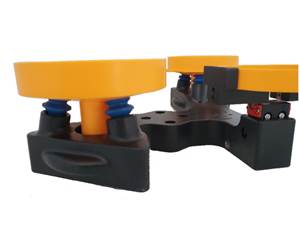Injection Molding Close-Up
What's New in Micro-Molding
The latest development in the D-I-M technology is a vertical press with vertical injector, measuring around 5 x 2.7 x 8.8 ft high (with mold open). It allows plenty of room for automation, so it can be integrated into assembly lines, Ettlinger says.
What’s New in Micro-Molding: An Injector Inside the Mold
Here’s a novel approach to the rapidly developing field of micro-molding. It’s a variation on two-stage injection—but with an in-line screw and plunger combination that delivers shot weights from 0.1 to 4.5 grams. The plasticating cylinder and plunger are joined together into one reciprocating member. The plunger is actually an extension of the injection nozzle, which extends into the mold and hot-runner system. Further, the hot-runner system is an integral part of the molding machine. In what is said to be a cost-saving arrangement, most of the runnerless hot half, the mold base, and the stationary platen are one and the same.
This patented system, called “Direct Injection Molding” or D-I-M, comes from Ettlinger Kunststoffmaschinen GmbH in Konigsbrunn, Germany. The model ET 10/16 1 is a compact system with a tiebarless, 11-ton clamp and total footprint of about 6 x 2 ft x 5 ft high. It was shown for the first time at the K’98 show in Dusseldorf.
Ettlinger launched a coinjection version at the Interplas ’99 show in the U.K in October, where D-I-M technology won the top Innovation Award for capital equipment from the Plastics Machinery Distributors Association and British Polymer Training Association.
The latest development in the D-I-M technology is a vertical press with vertical injector, measuring around 5 x 2.7 x 8.8 ft high (with mold open). It allows plenty of room for automation, so it can be integrated into assembly lines, Ettlinger says. The company delivered the first two vertical units, both for coinjection, in November to a German automotive molder as a beta test site.
Homogenous melt
D-I-M technology is designed for high-precision injection and very consistent melt quality, says Ettlinger. Melt is more consistent because the 16-mm plasticating screw does not reciprocate within the barrel, so the entire shot “sees” the same screw L/D (20:1). Unlike some conventional two-stage systems, the in-line arrangement is said to give true first-in/first-out performance without risk of melt hang-up and inconsistent residence times.
The heart of the D-I-M technology is its plunger, which is, in effect, an extended nozzle with a non-return valve on its end. The entire plasticating unit moves forward to inject melt into the cavity. Injection stroke (up to 2 in.) is measured with a linear transducer.
The plunger tip is a check valve that permits “extremely precise dosing of the smallest shot volumes with very good repeatability and minimum dwell times,” according to Ettlinger. The hollow plunger can be of 0.2, 0.3, or 0.4 in. diam. for shot capacities of 1.6, 3.0, and 4.7 cc. Injection-pressure range is 14,510 to 36,275 psi.
The shooting pot, which is located inside the platen, feeds directly into two, four, or eight valve gates of 0.02-0.06 in. diam. The valve pins (whose actuating cylinders are built into the platen) prevent any leakage of melt while the shooting pot is being filled by the screw.
Ettlinger’s D-I-M model has a touchscreen color monitor on which all barrel and mold temperatures can be set.
Price for the D-I-M system starts at around $40,000 for a one-component, horizontal model and roughly doubles with the addition of coinjection and other options.
Ettlinger’s D-I-M micromolding system does not reciprocate the screw, but rather the entire injection unit, whose nozzle extends into the platen to serve as the injection plunger.
The extended nozzle has a check valve at the tip, which prevents back flow into the cylinder. The heated shooting pot inside the platen feeds directly into valve-gate nozzles.
Ettlinger’s 11-ton press is also available in vertical and coinjection models.
The tiebarless clamp takes a maximum mold size of 128 x 90 mm.
Related Content
BMW Group Vehicle to Adopt 3D Printed Center Console
A vehicle coming to market in 2027 will include a center console carrier manufactured through polymer robot-based large-format additive manufacturing (LFAM).
Read MoreEnsuring Repeatability: The Key to Effective Injection Molding Automation
One of automation’s key promises is repeatability: the same movement to the same location, time and time again. But to achieve that, all elements involved — robot, machine, EOAT, mold — must be in and stay in alignment.
Read MoreScaling New Heights With Vertical Integration
Eden Manufacturing was founded on a vision of vertical integration, adding advanced injection molding capabilities to a base of precision moldmaking and more recently bringing Swiss-type machining capabilities in-house.
Read MorePaperless ‘Smart Factory’ Based on Automated Production Monitoring
Tier 1 automotive molder’s home-built production-monitoring and ERP systems, designed for “the little guy,” boost its efficiency rating and profits.
Read MoreRead Next
Making the Circular Economy a Reality
Driven by brand owner demands and new worldwide legislation, the entire supply chain is working toward the shift to circularity, with some evidence the circular economy has already begun.
Read MoreFor PLASTICS' CEO Seaholm, NPE to Shine Light on Sustainability Successes
With advocacy, communication and sustainability as three main pillars, Seaholm leads a trade association to NPE that ‘is more active today than we have ever been.’
Read More










